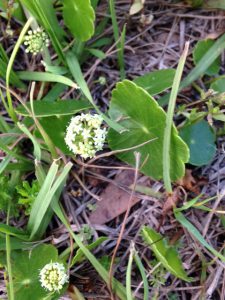Nearly everyone likes turfgrass lawns. They’re pretty and green. They filter water, chemicals, and nutrients before they enter our groundwater systems. They provide a recreation spot for people and pets. But lawns also come with maintenance tasks, one of which is weed control. Fortunately, keeping our common Centipedegrass lawns relatively weed free is as simple as smart management and utilizing herbicides effectively. Though the number of herbicides available for purchase can be overwhelming, you only need three to keep weeds at bay – a selective grass herbicide, a strong broadleaf herbicide, and a sedge herbicide!

Dollarweed, one of the toughest broadleaf weeds for homeowners to control. Picture courtesy of Julie McConnell, UF/IFAS.
First up on the essential herbicide list is the selective grass herbicide Sethoxydim. While most folks’ weed focus is centered on broadleaf weeds, grassy weeds like Crabgrass, Bahiagrass, Goosegrass, and others can be just as problematic and make for a very unsightly lawn. Enter Sethoxydim. Cheap and easy to find, Sethoxydim is offered as the active ingredient in many branded products like Fertilome Over the Top Grass Killer, Hi-Yield Grass Killer, and many more. These products control weedy grass species without seriously harming Centipedegrass or broadleaf ornamental trees and shrubs (Centipedegrass may temporarily be yellowed after sethoxydim application but will recover). Not only will it kill out the unwanted grass growing in your Centipede, but it will also remove these weeds from your flower beds!
Second, having a strong broadleaf herbicide on hand is necessary. I say “strong” because many of the homeowner grade products available at garden centers simply don’t have the “juice” to control tough broadleaf weeds like Dollarweed, Doveweed, Virginia Buttonweed, and others. For this job, I prefer to use a commercial grade 3-way product like Celsius WG by Bayer. Celsius WG is a 3-way combination herbicide with a healthy dose of Dicamba as its primary ingredient. Though Dicamba is a notoriously volatile chemical known to cause damage to unintended plants through drift in hot weather, combining it with the two other products in Celsius WG makes it safe to use in lawns, even in the heat of summer. While strong broadleaf herbicides like Celsius WG are expensive on the front end, don’t let that deter you. These products wind up being very cost effective in the long run due to minute mixing rates (one bottle goes a very long way in most residential lawns) and effectiveness – you simply will not need to waste time and money spraying lawn weeds over and over to obtain control like is necessary with lesser products – one or two applications will solve the toughest broadleaf weed problems.
Finally, any good lawn weed control program will include a quality sedge control herbicide. Sedges (often called “nutgrass”) look like grasses but are a completely different category of plants and as such, require specialized herbicide chemistries to achieve control. Sedge weeds prefer wetter areas of lawns, though they can occur in pretty much any lawn site and are very unsightly. For this weed category, there are several options available to homeowners. The one that consistently provides the best control in lawns is Halosulfuron-methyl, the active ingredient in the aptly named product Sedgehammer. Conveniently coming in individually pre-mixed packets for small lawns or a larger bottle when more acreage is to be treated, Sedgehammer couldn’t be easier to mix and use. While Sedgehammer and similar products are extremely effective in controlling various sedge weeds, they tend to work very slowly, and patience is required. Weeds immediately stop growing following a Sedgehammer application, but it can take up to three weeks to notice the sedges dying.
While having and using the above three herbicides can control almost any weed homeowners may encounter in their lawns, it is important to remember that herbicides are not substitutes for proper lawn management. When good cultural practices in lawns are followed, such as mowing at the correct height, only watering when necessary, following UF/IFAS fertilizer recommendations, etc., chemical weed control may not even be necessary in many cases! Also, once the decision to purchase and use chemical herbicides has been made, it is critical that one always read the label before using any herbicide product. This ensures safe and effective use of the product; the label is literally the law!
For assistance in choosing the correct herbicide for your lawn and other lawn care concerns, contact your local UF/IFAS Extension Office! Happy Gardening!
- Doveweed Control in Centipedegrass Lawns & Landscaped Beds - June 5, 2025
- Another Plea to End Crape Murder - April 21, 2025
- Roadside Red Blooms – Red Maples Showing Off This Spring - March 6, 2025
